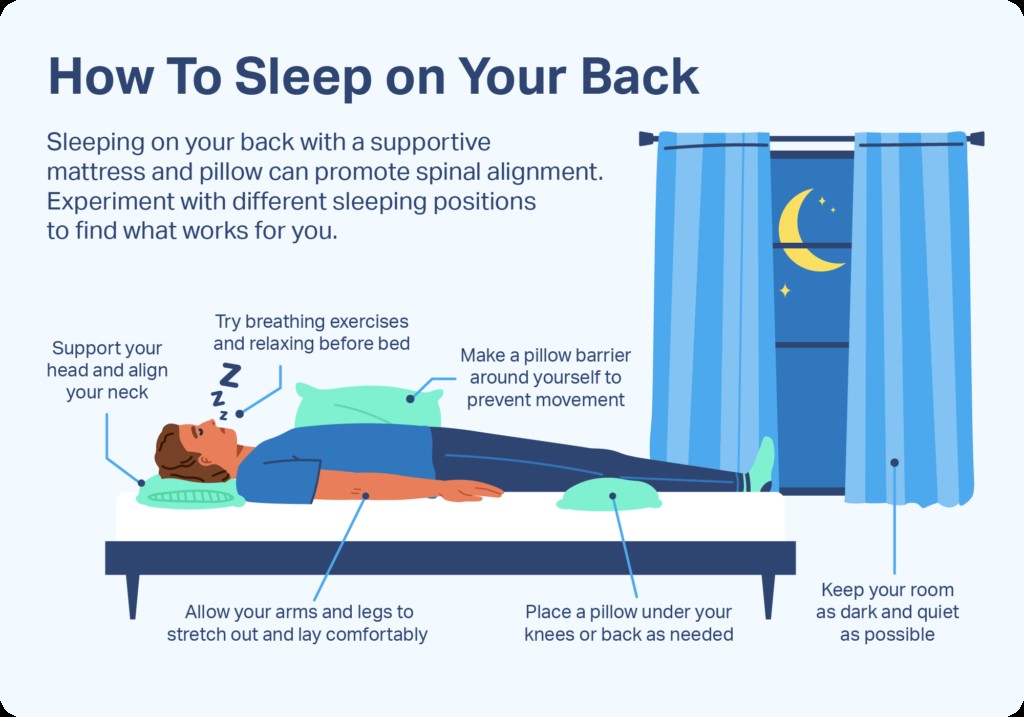Sleeping on your back is often lauded for its health benefits, from promoting spinal alignment to reducing wrinkles. Yet, for many, the reality of lying flat on their back in bed is far from comfortable. If you find yourself tossing and turning, wondering “why can’t I sleep on my back?”, you’re not alone. While it’s the second most common sleep position, transitioning to back sleeping or simply finding comfort in this position can be a real challenge.
This article delves into the common reasons why sleeping on your back might be uncomfortable and provides practical, expert-backed solutions to help you achieve restful sleep in this position. We’ll explore the advantages of back sleeping, address the discomforts, and guide you on how to train yourself for a better night’s rest on your back.
Benefits of Sleeping on Your Back
Before diving into the discomfort, it’s important to understand why many people aim to sleep on their back. This position offers several potential health advantages:
Spinal Alignment
One of the primary benefits of back sleeping is its ability to promote spinal alignment. When you lie on your back, your weight is evenly distributed, reducing pressure points and allowing your spine to maintain its natural curve. This can be particularly beneficial for individuals seeking relief from back pain. However, this benefit is contingent on having a supportive mattress and pillow that properly accommodate this position.
Reduced Wrinkles
For those concerned about skin aging, back sleeping can be a proactive step in reducing wrinkles. Unlike side or stomach sleeping, back sleeping minimizes facial contact with the pillow. The constant pressure and friction from pressing your face against a pillow throughout the night can contribute to the formation of sleep wrinkles over time. By sleeping on your back, you avoid this pressure, potentially leading to fewer wrinkles in the long run.
Heartburn Relief
If you experience heartburn or acid reflux, sleeping on your back with your head slightly elevated can alleviate symptoms. Gravity works in your favor in this position, helping to keep stomach acid down and reducing the likelihood of it flowing back into the esophagus. Elevating your head can be easily achieved with an adjustable bed or by using a wedge pillow.
Alt text: Man peacefully sleeping on his back, illustrating the spinal alignment benefits of this sleep position.
Why You Might Struggle to Sleep on Your Back
Despite the advantages, many people find back sleeping inherently uncomfortable. Here are some common reasons why you might be struggling to sleep on your back:
Uncomfortable Mattress and Pillow
An unsupportive mattress or the wrong pillow are major culprits behind back sleeping discomfort. If your mattress is too old, too soft, or too firm, it may not provide the necessary support for your spine in a back-sleeping position. Similarly, a pillow that is too thick or too flat can misalign your neck, leading to neck pain and overall discomfort. For back sleepers, a medium-firm mattress and a pillow with moderate loft are generally recommended to maintain spinal alignment.
Lower Back Pain
Ironically, while back sleeping can be good for spinal alignment, it can also exacerbate lower back pain for some individuals. Lying flat on your back can increase pressure on the lower spine if it’s not properly supported. This is especially true for people with pre-existing lower back conditions. However, this discomfort can often be mitigated with proper support, as discussed later in the tips section.
Feeling Exposed or Vulnerable
Psychologically, some individuals feel exposed and vulnerable when sleeping on their back. Side and stomach sleeping can offer a sense of security and being protected, whereas back sleeping can feel open and less secure. This feeling, although subjective, can contribute to restlessness and difficulty falling asleep on your back.
Snoring and Sleep Apnea Concerns
For individuals who snore or have obstructive sleep apnea (OSA), back sleeping can worsen these conditions. In the supine position, gravity can cause the tongue and soft tissues in the throat to relax and collapse into the airway, leading to increased snoring and potentially more severe sleep apnea episodes. This is a significant concern and a primary reason why medical professionals often advise those with these conditions to sleep on their side.
Tips to Make Back Sleeping More Comfortable
If you’re determined to reap the benefits of back sleeping, or if you’ve been advised to sleep on your back for medical reasons, there are several techniques you can employ to enhance comfort and train yourself to stay in this position throughout the night.
Place a Pillow Underneath Your Knees
One of the most effective methods to improve back sleeping comfort is to place a pillow under your knees. This simple adjustment helps to bend your knees slightly, which in turn flattens your lower back against the mattress. This reduces strain on the lumbar spine and can significantly alleviate lower back discomfort. Use a thin to medium-loft pillow and ensure your knees are only slightly bent, maintaining a natural and comfortable position.
Place a Pillow Under Your Lower Back
For some, additional lumbar support is needed. A small, thin pillow placed under your lower back can provide extra cushioning and maintain the natural curve of your spine. However, be cautious not to use a pillow that is too thick, as this can overextend your back and cause more discomfort. Experiment with different pillow thicknesses to find what provides optimal support without causing strain.
Surround Yourself With Pillows
If you’re an active sleeper who tends to roll onto your side or stomach during the night, surrounding yourself with pillows can act as a physical barrier. Place pillows on either side of your body, particularly around your midsection and hips, to gently prevent you from rolling over. While this method can be effective, it might not be ideal if you share your bed, as it can take up considerable space.
Choose the Right Mattress and Pillow
Investing in a mattress specifically designed for back sleepers and a supportive pillow is crucial for long-term comfort. A medium-firm mattress generally provides the best balance of support and cushioning for back sleepers. Look for pillows that are labeled as suitable for back sleepers, often featuring a medium loft and contouring properties to cradle the neck while maintaining spinal alignment. Consider materials like memory foam or latex, which can offer excellent support and pressure relief.
Alt text: Person stretching arms above head in bed, representing preparation for comfortable sleep and addressing potential discomfort.
When Back Sleeping Might Not Be Right For You
While back sleeping offers benefits, it’s not the ideal position for everyone. There are certain situations where back sleeping might be contraindicated or less advisable:
Existing Snoring or Sleep Apnea
As mentioned earlier, back sleeping can exacerbate snoring and sleep apnea. If you know you are a heavy snorer or have been diagnosed with sleep apnea, side sleeping is generally recommended. If you still prefer back sleeping, consult with your doctor or a sleep specialist to discuss strategies to manage your snoring or sleep apnea, such as using a CPAP machine or other positional therapy devices.
Personal Preference and Comfort
Ultimately, personal preference plays a significant role in sleep position. If you’ve tried various techniques and still find back sleeping consistently uncomfortable or if you simply prefer another position, it’s perfectly acceptable to sleep in a way that feels most natural and restful for you. The most important aspect of sleep is that it’s restorative and allows you to wake up feeling refreshed.
Other Factors for Good Sleep
Your sleep position is just one piece of the puzzle when it comes to achieving quality sleep. Regardless of whether you sleep on your back, side, or stomach, incorporating healthy sleep habits is essential:
- Maintain a Consistent Sleep Schedule: Go to bed and wake up around the same time each day, even on weekends, to regulate your body’s natural sleep-wake cycle.
- Establish a Relaxing Evening Routine: Wind down before bed with calming activities such as reading, taking a warm bath, or listening to relaxing music.
- Limit Caffeine and Alcohol Before Bed: Avoid stimulants like caffeine and alcohol close to bedtime, as they can disrupt your sleep.
- Create a Dark, Quiet, and Cool Sleep Environment: Optimize your bedroom for sleep by ensuring it’s dark, quiet, and kept at a cool, comfortable temperature.
- Reduce Screen Time Before Bed: Minimize exposure to blue light from screens (phones, tablets, computers) at least an hour before bed, as it can interfere with melatonin production and make it harder to fall asleep.
Conclusion
Struggling to sleep on your back is a common issue, often stemming from discomfort related to mattress and pillow support, lower back strain, or even psychological factors. However, by understanding the reasons behind your discomfort and implementing the strategies outlined – such as using pillows for support and choosing the right sleep products – you can improve your comfort and potentially train yourself to sleep on your back.
While back sleeping offers several benefits, it’s crucial to listen to your body and prioritize overall sleep quality. If back sleeping consistently feels unnatural or exacerbates existing conditions like snoring or sleep apnea, side sleeping remains a healthy and viable alternative. Experiment with different techniques and consult with a sleep professional if you have persistent sleep difficulties to find the best approach for your individual needs and ensure you’re getting the restful sleep you deserve.

